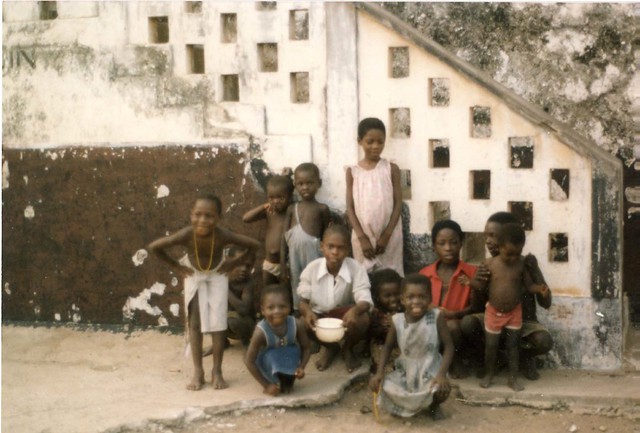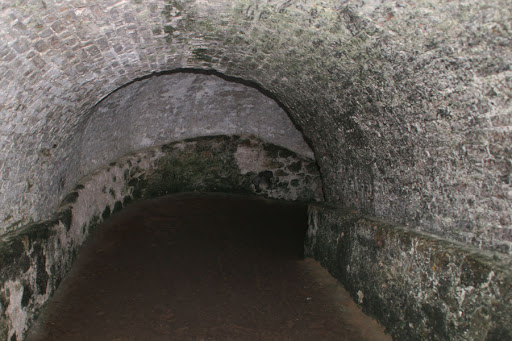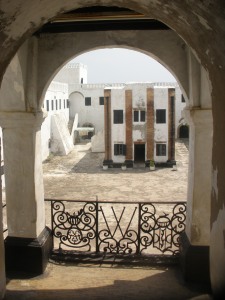
From the Seattle Times, on ,"Ghana slave forts produce torrent of tears," by Molly Hennessy Fiske (Newhouse News Service) -- GHANA — I did not cry during my first slave fort tour last summer.
At Cape Coast Castle, I descended into the damp stone dungeon where slaves were held. I crossed the lightless basement cell where slave women were raped by their captors.
Outside, I walked white-castle parapets with their iron cannons and panoramic views of the great, green ocean that swallowed millions of slaves. Below, fishermen cast nets into the water.

As I was leaving, I saw a black-and-white composition notebook labeled "Visitor's Comments." I opened it and scanned dozens of entries from the United States, United Kingdom, Caribbean, Australia, Asia and Africa, stopping at a Ghanaian woman, whose words made me sob:
"Cape Coast Castle is the most popular and well known to visit attraction in Ghana. Hundreds of tourists have passed through these gates and witnessed the devastation of the slave trade. I am appealing to the management of this site to mobilize a development initiative for the people of Cape Coast who are still suffering even though they've welcomed so many visitors. The central region is the fourth poorest region. I am appealing to all visitors. This is shameful that nothing is done."
Ghana's dozen slave forts were once the epicenter of the trans-Atlantic trade, sending more slaves to America's shores than any other part of Africa during the 18th century. At the height of the slave trade, as many as 60 forts and castles dotted the slave coast of West Africa, according to the Ghana Museums and Monuments Board.
They became American tourist attractions during the 1970s, when Alex Haley's "Roots" popularized slave history and the United Nations anointed the forts historic landmarks.
But why cross an ocean, then a jungle, to confront such poverty, the legacy of slavery?
I found the answer walking the hallways of two castles and a fort with fellow travelers, watching them touch the walls, recoil from history and reach out to ancestors.
The tour guides, all Ghanaian, steered us along well-traveled paths through the buildings — usually ending at gift shops — then let us roam.

Cape Coast Castle
Cape Coast Castle was built by Swedish forces in 1654. The guide told me he usually divides tour groups by nationality: Europeans in one, Americans in another. The castle tends to make Europeans angry, he said, and Americans upset.
The Americans and Europeans I saw started out curious. A white American woman asked how long slaves were held in Cape Coast cells. About six weeks, he said.
An African-American artist asked the purpose of a small mound of wreaths across from the dungeon. A shrine honoring slaves, the guide said. The artist began to weep. Another African-American woman reached out in the dark and embraced her.

The guide led us on, into a cell of suffocating, damp darkness. He packed us in, just as the slaves were. "They died so painfully," he said. "Some may have scratched the walls." We looked. No one dared touch.
We clambered back up to the castle courtyard, following the guide to a door marked "Door of No Return." Slave ships once docked just outside. We walked through.
On the other side, we faced the poverty the woman wrote about in the comment book: Fishermen mending nets, fishwives carting mackerel in basins on their heads; child vendors selling dark African chocolate.

Elmina Castle
Elmina CastleI began to understand Europeans' anger during a tour of Elmina Castle, about a half-hour's drive west of Cape Coast.
Erected by the Portuguese in 1482, Elmina was later occupied by the Dutch. The tour began in front of a cell marked with a black-and-white plaster skull above the entrance.
"This became the death cell, the cell of no return," the guide said, home to unruly slaves. "That's why the Dutch put the skull and crossbones over it."

As our guide led the group up to the Dutch governor's quarters, he explained that the lofty, wooden hall, full of wide windows and fresh sea air, was built above the dungeons.
The governor would send for slave women from below, the guide said.
I asked the guide about my fellow visitors. About 75 percent are foreigners, he said; 55 percent white. Our group included a few European students on holiday, one of them Dutch. She translated an inscription above the governor's bay window: "Zion is The Lord's Habitation."
I climbed up a narrow wooden staircase in Elmina's tower to a 10-foot-square platform. The 360-degree view spanned the fishing village, the seaside castle flanked by palms and the Gulf of Guinea beyond.
Fishermen's 50-foot canoes, multicolored pirogues flying matching flags, fill Benya Lagoon. It's easy to imagine them replaced by 18th-century schooners bound for America.

Fort St. Jago
Fort St. Jago is the only one of the slave prisons among those I visited with a guide in residence. Others to the west, neglected by a government with debt in the billions, are inhabited by fishing families, whose laundry flaps from the rusting cannons.
The fort is smaller than the two castles I visited, which contain a network of buildings that could sustain a large population.
There are moments when you feel your life changing. For me, the moment came after I returned from the slave castles to my hilltop hotel, the Mighty Victory.
I shared the room with photographer Michelle Gabel, who snapped my picture as I cried over the Cape Coast comment book. Embarrassed by my tears, I shut myself in the bathroom to write.
"Just back from Cape Coast, and I am thinking how fortunate I am to be here and see what I've seen and that I should enjoy it and not be sad," I wrote. "I guess I'm more angry, crying angry."
Despite my tears, my fears and weaknesses, I did not look away. I recorded what I saw. And I thought again of that woman's words, of what we are willing to pay to confront history, see the lessons and share them. [Copyright © 2006 The Seattle Times Company]

This was absolutely beautiful. I want to be able to go to see these castles for myself. Just reading your words, has bought tears to my eyes. I'm sure I'd be the one crying on the tour. Thanks for taking me there with you.
ReplyDelete